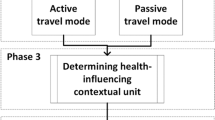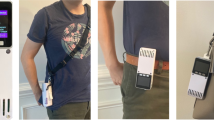Abstract
Background
A critical aspect of air pollution exposure assessments is determining the time spent in various microenvironments (ME), which can have substantially different pollutant concentrations. We previously developed and evaluated a ME classification model, called Microenvironment Tracker (MicroTrac), to estimate time of day and duration spent in eight MEs (indoors and outdoors at home, work, school; inside vehicles; other locations) based on input data from global positioning system (GPS) loggers.
Objective
In this study, we extended MicroTrac and evaluated the ability of using geolocation data from smartphones to determine the time spent in the MEs.
Method
We performed a panel study, and the MicroTrac estimates based on data from smartphones and GPS loggers were compared to 37 days of diary data across five participants.
Results
The MEs were correctly classified for 98.1% and 98.3% of the time spent by the participants using smartphones and GPS loggers, respectively.
Significance
Our study demonstrates the extended capability of using ubiquitous smartphone data with MicroTrac to help reduce time-location uncertainty in air pollution exposure models for epidemiologic and exposure field studies.
This is a preview of subscription content, access via your institution
Access options
Subscribe to this journal
Receive 6 print issues and online access
$259.00 per year
only $43.17 per issue
Buy this article
- Purchase on Springer Link
- Instant access to full article PDF
Prices may be subject to local taxes which are calculated during checkout


Similar content being viewed by others
Data availability
The data collected and processed from this study are available from the corresponding author on reasonable request.
References
US Environmental Protection Agency. Integrated science assessment for particulate matter. In EPA600/R-08/139F; Environmental Protection Agency: Washington, DC, USA, 2009.
US Environmental Protection Agency. Integrated science assessment for ozone and related photochemical oxidants. In EPA 600/R-10/076F; Environmental Protection Agency: Washington, DC, USA, 2013.
Zeger SL, Thomas D, Dominici F, Sarnet JM, Schwartz J, Dockery D, et al. Exposure measurement error in time-series studies of air pollution: Concepts and consequences. Environ Health Perspect. 2000;108:419–26.
Sheppard L, Burnett RT, Szpiro AA, Kim SY, Jerrett M, Pope CA III, et al. Confounding and exposure measurement error in air pollution epidemiology. Air Qual Atmos Health. 2012;5:203–16.
National Research Council. Exposure Science in the 21st Century: A Vision and a Strategy; The National Academies Press: Washington, DC, USA, 2012.
National Research Council. Research Priorities for Airborne Particulate Matter: I. Immediate Priorities and a Long-Range Research Portfolio; The National Academies Press: Washington, DC, USA, 2004.
National Academies of Sciences, Engineering, and Medicine. Health Risks of Indoor Exposure to Particulate Matter: Workshop Summary; The National Academies Press: Washington, DC, USA, 2016.
National Academies of Sciences, Engineering, and Medicine. Using 21st Century Science to Improve Risk-Related Evaluations; The National Academies Press: Washington, DC, USA, 2017.
Breen MS, Seppanen C, Isakov V, Arunachalam S, Breen M, Samet J, et al. Development of TracMyAir smartphone application for modeling exposures to ambient PM2.5 and Ozone. Int J Environ Res Public Health. 2019. https://doi.org/10.3390/ijerph16183468
Peltier RE, Buckley TJ. Sensor technology: a critical cutting edge of exposure science. J Exp Sci Environ Epidemiol. 2020;30:901–2.
Breen MS, Long T, Schultz B, Crooks J, Breen M, Langstaff J, et al. GPS-based microenvironment tracker (MicroTrac) model to estimate time-location of individuals for air pollution exposure assessments: model evaluation in central North Carolina. J Exp Sci Environ Epidemiol. 2014;24:412–20.
Donaire-Gonzalez D, Valentín A, de Nazelle A, Ambros A, Carrasco-Turigas G, Seto E, et al. Benefits of mobile phone technology for personal environmental monitoring. JMIR Mhealth Uhealth. 2016;4:e126 https://doi.org/10.2196/mhealth.5771. PMID: 27833069; PMCID: PMC5122720
Asimina S, Chapizanis D, Karakitsios S, Kontoroupis P, Asimakopoulos DN, Maggos T, et al. Assessing and enhancing the utility of low-cost activity and location sensors for exposure studies. Environ Monit Assess. 2018;190:155 https://doi.org/10.1007/s10661-018-6537-2. PMID: 29464404
National Academy of Engineering 2022. Indoor Exposure to Fine Particulate Matter and Practical Mitigation Approaches: Proceedings of a Workshop. Washington, DC: The National Academies Press. https://doi.org/10.17226/26331.
Quinn C, Anderson GB, Magzamen S, Henry CS, Volckens J. Dynamic classification of personal microenvironments using a suite of wearable, low-cost sensors. J Expo Sci Environ Epidemiol. 2020;30:962–70. https://doi.org/10.1038/s41370-019-0198-2. Epub 2020 Jan 14. Erratum in: J Expo Sci Environ Epidemiol. 2020 Mar 5;: PMID: 31937850; PMCID: PMC7358126
Adams C, Riggs P, Volckens J. Development of a method for personal, spatiotemporal exposure assessment. J Environ Monit. 2009;11:1331–9.
Tandon P, Saelens B, Zhou C, Kerr J, Christakis D. Indoor versus outdoor time in preschoolers at child care. Am J Prev Med. 2013;1:85–88.
McCurdy T, Glen G, Smith L, Lakkadi Y. The national exposure research laboratory’s Consolidated Human Activity Database. J Expo Anal Environ Epidemiol. 2000;10:566–78.
Acknowledgements
We thank Timothy Buckley and David Heist for their review comments and helpful suggestions. All contributions from H. Christopher Frey occurred prior to taking a leave of absence from North Carolina State University for an appointment at the US EPA as the Deputy Assistant Administrator for Science Policy in the Office of Research and Development. Although the manuscript was reviewed by the US EPA and approved for publication, it may not necessarily reflect official Agency policy. Mention of trade names or commercial products does not constitute endorsement or recommendation for use.
Author information
Authors and Affiliations
Contributions
MSB was responsible for designing the study, extracting and analysing data, interpreting results, and writing report. YX was responsible for designing the study, extracting and analysing data, interpreting results, and writing report. HCF was responsible for designing the study, extracting and analysing data, interpreting results, writing report. MB was responsible for interpreting results and writing report. VI was responsible for interpreting results and writing report.
Corresponding author
Ethics declarations
Competing interests
The authors declare no competing interests.
Ethical approval
The procedures involving humans were reviewed and approved by the US EPA Human Subjects Research Review Official.
Additional information
Publisher’s note Springer Nature remains neutral with regard to jurisdictional claims in published maps and institutional affiliations.
Supplementary information
Rights and permissions
About this article
Cite this article
Breen, M.S., Xu, Y., Christopher Frey, H. et al. Microenvironment Tracker (MicroTrac) model to estimate time-location of individuals for air pollution exposure assessments: model evaluation using smartphone data. J Expo Sci Environ Epidemiol 33, 407–415 (2023). https://doi.org/10.1038/s41370-022-00514-w
Received:
Revised:
Accepted:
Published:
Issue Date:
DOI: https://doi.org/10.1038/s41370-022-00514-w



